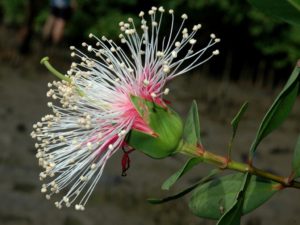The Sweet Conservation of Mangroves
Protecting mangroves while producing honey in Ban Nai Nang, Thailand
“When Mangrove Action Project (MAP) came, they showed us what we already knew, but highlighted exactly how to do it, and told us to listen to what nature was telling us”
--- Sutee Pankwan,
Head of Nai Nang apiculture group
MAP has been collaborating with the people of Nai Nang village in Krabi Province, Thailand, to produce “Nai Nang Honey” from the surrounding mangrove forests while conserving them.
The bee keeping collective originated from a conservation group that worked to restore the mangrove forest surrounding their village, whilst using bees to assist with their pollination. In 2014, several members of the conservation group decided to form an apiculture group to generate alternative income from the honey products, with technical training and assistance from Mangrove Action Project. Today, the collective includes over 45 families who depend primarily on traditional small-scale fishing, and farming for their livelihoods.
The village now has more than 300 beehives and produced 194 litres of raw, unpasteurized honey in 2018, down from 270L in 2015. The group earned an income of 116,495 baht (3,700 USD) from raw honey and other honey value-added products made by the women’s group. A new enterprise for the Nai Nang cooperative is constructing and installing new beehive boxes in other communities and selling to visiting groups which earned 340,400 Baht (10,810 USD) in 2018. Through workshops, the Nai Nang Women’s Group has also learned to produce a variety of honey based value-added products such as medicinal balm, shampoo, conditioner, body lotion, liquid body and bar soap and a village Conservation Fund was established with 10% of all honey and honey product sales.
The Nai Nang Apiculture Group has established a partnership with the “Phuket Marriott Resort & Spa, Merlin Beach”, the “Phulay Bay: A Ritz-Carton Reserve” and the “Aonang Princeville Villa Resort & Spa”. These hotels have established a display about the Nai Nang cooperative and are using the honey in their restaurants while creating a retail outlet in their gift shops.
The Nai Nang group even has future plans to also sell their honey and products on-line.

Photo: MAP
From Mangrove to Honey
 All the honey from the Nai Nang apiculture group is sourced locally from wooden boxes which are colonized by wild bees (Apis cerana). Honey is harvested only once per year. The bees gather nectar from the seasonal flower blossoms of fruit orchards and a variety of mangrove species such as Avicennia alba, Excoecaria agallocha, Flagellaria indica, Phoenix paludosa, Xylocapus moluccensis, and Sonneratia caseolaris (pictured right, photo: MAP).
All the honey from the Nai Nang apiculture group is sourced locally from wooden boxes which are colonized by wild bees (Apis cerana). Honey is harvested only once per year. The bees gather nectar from the seasonal flower blossoms of fruit orchards and a variety of mangrove species such as Avicennia alba, Excoecaria agallocha, Flagellaria indica, Phoenix paludosa, Xylocapus moluccensis, and Sonneratia caseolaris (pictured right, photo: MAP).
This unique combination of nectar gives the honey a distinctive taste that has a hint of sea salt.
Beginning the Journey in Ban Ta-Sanook
In March 2016 the experienced members of Nai Nang Village offered knowledge exchange training in an apiculture workshop for a neighboring village, Ban Ta-Sanook in Phang Nga province. Apiculture is just one of many community initiatives providing prosperity while preserving and enhancing the ecosystem services of mangroves and Ban Ta-Sanook is only at the beginning of their journey. They’re now building their own bee boxes so that wild bees will naturally colonize them. The community also has a 70 meter long “Mangrove Interpretative Nature Trail” built with the financial assistance from MAP which is a great asset for visitors and they have an active Environmental Education program taking place in local schools. The ultimate aim is that the twinned communities are able to support each other in their apiculture enterprises.

Mangrove restoration in the Nai Nang forests ensures healthy habitat and food for their bees. Photo: MAP